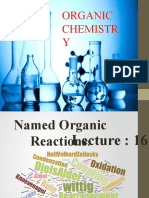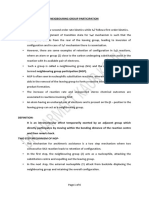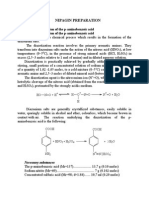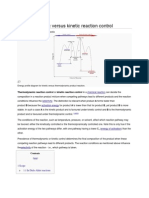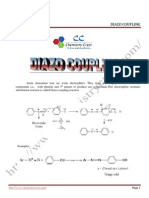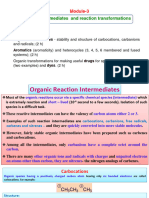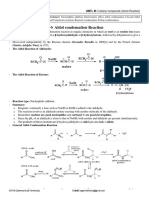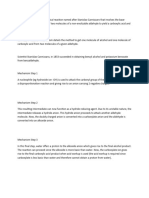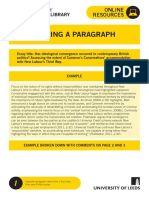Cannizzaro Reaction - Mechanism, Examples With Illustrations
Cannizzaro Reaction - Mechanism, Examples With Illustrations
Uploaded by
Hanin LatpiCopyright:
Available Formats
Cannizzaro Reaction - Mechanism, Examples With Illustrations
Cannizzaro Reaction - Mechanism, Examples With Illustrations
Uploaded by
Hanin LatpiOriginal Title
Copyright
Available Formats
Share this document
Did you find this document useful?
Is this content inappropriate?
Copyright:
Available Formats
Cannizzaro Reaction - Mechanism, Examples With Illustrations
Cannizzaro Reaction - Mechanism, Examples With Illustrations
Uploaded by
Hanin LatpiCopyright:
Available Formats
Mechanism of Cannizzaro Reaction
Mechanism Step 1
A nucleophile such as a hydroxide ion is used to attack the carbonyl group of the given
aldehyde, causing a disproportionation reaction and giving rise to an anion carrying 2
negative charges.
Mechanism Step 2
This resulting intermediate can now function as a hydride reducing agent. Due to its
unstable nature, the intermediate releases a hydride anion. This hydride anion proceeds
to attack another aldehyde molecule. Now, the doubly charged anion is converted into a
carboxylate anion and the aldehyde is converted into an alkoxide anion.
Mechanism Step 3
In this final step, water offers a proton to the alkoxide anion which gives rise to the final
alcohol product. The reaction can proceed since the alkoxide is more basic than water.
Now, the carboxylate ion gives rise to the final carboxylic acid product when acid
workup is used (the acid workup is required since carboxylate is less basic than water
and therefore cannot obtain a proton from water).
You might also like
- CHEM35.1 E7 Cannizzaro ReactionDocument4 pagesCHEM35.1 E7 Cannizzaro ReactionGlenn Vincent Tumimbang88% (8)
- Carboxylic Acids Carboxylic Acids Carboxylic Acids Carboxylic AcidsDocument25 pagesCarboxylic Acids Carboxylic Acids Carboxylic Acids Carboxylic AcidsOhmark VeloriaNo ratings yet
- Neighbouring Group Participation or NGP inDocument4 pagesNeighbouring Group Participation or NGP inbharatbhushansankhya100% (1)
- Perkin ReactionDocument2 pagesPerkin Reactionrajaraghuramvarma100% (1)
- ReactionDocument54 pagesReactionAhmed ImranNo ratings yet
- CHEM35 1 E7 Cannizzaro Reaction PDFDocument4 pagesCHEM35 1 E7 Cannizzaro Reaction PDFSherlHolmesNo ratings yet
- 306 Cannizzaro ReactionDocument9 pages306 Cannizzaro Reactionayesha sanaNo ratings yet
- Catalytic Hydrogenations: Birch ReductionDocument9 pagesCatalytic Hydrogenations: Birch ReductionAnamikaNo ratings yet
- Alcohol Ether and ExpoksideDocument64 pagesAlcohol Ether and ExpoksideAhmadBadruzzamanShuib100% (1)
- Cannizaro ReactionsDocument3 pagesCannizaro ReactionsvrchemieNo ratings yet
- Ch07 LectureDocument87 pagesCh07 Lectureshantalle gabrielNo ratings yet
- Carboxylic Acid Derivatives: Organic Chemistry, 5Document62 pagesCarboxylic Acid Derivatives: Organic Chemistry, 5CV Sumber Mutiara AbadiNo ratings yet
- Organic Chemistry,: AlkenesDocument52 pagesOrganic Chemistry,: AlkenesAnnisa Ayu NurarifaNo ratings yet
- Organic Chemistry For USTH Students Lecture 2: Electrophilic Addition To C CDocument107 pagesOrganic Chemistry For USTH Students Lecture 2: Electrophilic Addition To C CminhminhNo ratings yet
- Advanced Organic Chemistry (20CY209)Document26 pagesAdvanced Organic Chemistry (20CY209)Anandarup GoswamiNo ratings yet
- Cannizzaros ReactionDocument8 pagesCannizzaros Reactionabubakar siddiqueNo ratings yet
- NGP ReactionDocument6 pagesNGP Reactionjeeadvance100% (1)
- Module 2.3 NGP PDFDocument3 pagesModule 2.3 NGP PDFIshaan ChaturvediNo ratings yet
- Chapter 7b Lecture SN1 and E1 PDFDocument113 pagesChapter 7b Lecture SN1 and E1 PDFjoseph changNo ratings yet
- Free RadicalsDocument15 pagesFree Radicalsمحمود محمدNo ratings yet
- Cannizzaro Reaction ReportDocument15 pagesCannizzaro Reaction ReportRafal A MkNo ratings yet
- Chapter 11-Reactions of Alcohols: 3° Alcohols Are Resistant To OxidationDocument30 pagesChapter 11-Reactions of Alcohols: 3° Alcohols Are Resistant To Oxidation張湧浩No ratings yet
- Chapter 12 Lecture PDFDocument156 pagesChapter 12 Lecture PDFjoseph changNo ratings yet
- Experiment 8 Synthesis of An Azo Dye - The Coupling Reaction of Benzenediazonium Ion With Naphthalen-2-OlDocument9 pagesExperiment 8 Synthesis of An Azo Dye - The Coupling Reaction of Benzenediazonium Ion With Naphthalen-2-OlShivam SinghNo ratings yet
- Organic Chemistry,: Alcohols, Ethers, EpoxidesDocument69 pagesOrganic Chemistry,: Alcohols, Ethers, EpoxidesilhamfaturachmanagusNo ratings yet
- P-Aminobenzoic Acid DiazotizationDocument3 pagesP-Aminobenzoic Acid DiazotizationAliİnce50% (2)
- Thermodynamic Versus Kinetic Reaction Control, Diffusion ControlDocument7 pagesThermodynamic Versus Kinetic Reaction Control, Diffusion ControlenvirocompNo ratings yet
- Oxidation of Benzoin Into Benzil (N°39) : Tatiana Pachova BSC 2, Chemistry Assistant: Chandan Dey Sciences Ii - Lab. ADocument4 pagesOxidation of Benzoin Into Benzil (N°39) : Tatiana Pachova BSC 2, Chemistry Assistant: Chandan Dey Sciences Ii - Lab. ARabiaNo ratings yet
- Iodoform ReactionDocument5 pagesIodoform Reactionmarwazohdi100% (1)
- Chemistry of Prostaglandins, Leukotrienes and ThromboxanesDocument20 pagesChemistry of Prostaglandins, Leukotrienes and ThromboxanesAbhimanyu AwasthiNo ratings yet
- Ketones Can Be Converted Into Esters Via The Insertion of An Oxygen Atom Baeyer-Villiger OxidationDocument3 pagesKetones Can Be Converted Into Esters Via The Insertion of An Oxygen Atom Baeyer-Villiger OxidationDawit BirhanuNo ratings yet
- Chapter 11 - Reactions of Alcohol (Compatibility Mode)Document13 pagesChapter 11 - Reactions of Alcohol (Compatibility Mode)Billy HoNo ratings yet
- Possible electrolytes for SOFC: synthesis and characterization of Bi3-xMexTaO7-δ and others fluorite-related phasesDocument95 pagesPossible electrolytes for SOFC: synthesis and characterization of Bi3-xMexTaO7-δ and others fluorite-related phasesnicheltetracarbonileNo ratings yet
- Alkaloids 2 PDFDocument43 pagesAlkaloids 2 PDFMd. Hasanur RahmanNo ratings yet
- Chapter 1. Antihistamines: 1.1. HistamineDocument20 pagesChapter 1. Antihistamines: 1.1. HistamineJyotsana Dwivedi100% (1)
- YlideDocument13 pagesYlidePharaoh talk to youNo ratings yet
- Nitration (Lec 1)Document23 pagesNitration (Lec 1)UsamaNo ratings yet
- Handout3 Schrock CarbeneDocument3 pagesHandout3 Schrock CarbeneMior AfiqNo ratings yet
- 06 Chapter 1Document63 pages06 Chapter 1Kautsar NurfalaqNo ratings yet
- Hydrogenation of Alkene: Dr.V.Jeevanantham Ap/Chemistry For I M.SC StudentsDocument36 pagesHydrogenation of Alkene: Dr.V.Jeevanantham Ap/Chemistry For I M.SC StudentsJeevanantham VelayuthamNo ratings yet
- Unit 2 Step Growth PolymerizationDocument55 pagesUnit 2 Step Growth PolymerizationGoopNo ratings yet
- Diazo CouplingDocument3 pagesDiazo CouplingjanmanchiNo ratings yet
- 2-Organic Intermediates - Stability and Structure of Carbocations, Carbanions and Radicals-26!02!2022Document44 pages2-Organic Intermediates - Stability and Structure of Carbocations, Carbanions and Radicals-26!02!2022krishna sanapala2003No ratings yet
- Carboxylic AcidDocument6 pagesCarboxylic AcidVishu AgrawalNo ratings yet
- Favorskii RearrangementDocument4 pagesFavorskii RearrangementKaramdev NishadNo ratings yet
- Aliphatic Hydrocarbons: LAB #1 Reactions of HydrocarbonsDocument7 pagesAliphatic Hydrocarbons: LAB #1 Reactions of HydrocarbonsJoshuaArryNo ratings yet
- 06 Chapter 1Document63 pages06 Chapter 1Dintakurthi PrasanthNo ratings yet
- The Aqueous Phase ReactionDocument16 pagesThe Aqueous Phase ReactionRSL100% (1)
- Synthesis and Characterization of TrisDocument1 pageSynthesis and Characterization of TrisforfunNo ratings yet
- Lab Experiment 21 Report: Organic Chemistry Lab Tuesdays at 1:30Document4 pagesLab Experiment 21 Report: Organic Chemistry Lab Tuesdays at 1:30Johnathan DoeNo ratings yet
- Acid Base LectureDocument9 pagesAcid Base LectureJulia Kropel'nytskaNo ratings yet
- Chapter 18 - Carbonyl CompoundsDocument9 pagesChapter 18 - Carbonyl CompoundsNabindra RuwaliNo ratings yet
- Aldol Condensation Reaction: Charles-Adolphe Wurtz in 1872Document11 pagesAldol Condensation Reaction: Charles-Adolphe Wurtz in 1872neel721507No ratings yet
- PW-049a-Limiting Reagents-01Document5 pagesPW-049a-Limiting Reagents-01JoHan Xyth RizaldoNo ratings yet
- SN1, SN2, E1 and E2 Reactions in OCDocument60 pagesSN1, SN2, E1 and E2 Reactions in OCHimanshu SharmaNo ratings yet
- Smith 4th Ed Chap 9 Alcohols, Ethers and Epoxides (Fall 2013)Document47 pagesSmith 4th Ed Chap 9 Alcohols, Ethers and Epoxides (Fall 2013)Clifford PhilogeneNo ratings yet
- Experiment No.1 Date: Preperation of Benzaldehyde Phenyl Hydrazone From Phenyl Hydrazine AIMDocument24 pagesExperiment No.1 Date: Preperation of Benzaldehyde Phenyl Hydrazone From Phenyl Hydrazine AIMVarun Dev KrishnanNo ratings yet
- 9-Cannizzaro's Reaction: Reduced (Giving Primary Alcohol)Document5 pages9-Cannizzaro's Reaction: Reduced (Giving Primary Alcohol)maheen aurangzaibNo ratings yet
- Cannizzaro reac-WPS OfficeDocument2 pagesCannizzaro reac-WPS Officenharnahquophi8080No ratings yet
- Chapter 12 Mechanism of Reaction: Aldol CondensationDocument17 pagesChapter 12 Mechanism of Reaction: Aldol CondensationTiya KapoorNo ratings yet
- Writing A Paragraph: The University LibraryDocument3 pagesWriting A Paragraph: The University LibraryHanin LatpiNo ratings yet
- NOTES-Aromatic Substituents-Directing & Activating TrendsDocument4 pagesNOTES-Aromatic Substituents-Directing & Activating TrendsHanin LatpiNo ratings yet
- The Isolobal Principle and Application of Wade's Rules - Chap 5 AddDocument3 pagesThe Isolobal Principle and Application of Wade's Rules - Chap 5 AddHanin LatpiNo ratings yet
- Fischer ProjectionDocument4 pagesFischer ProjectionHanin LatpiNo ratings yet















